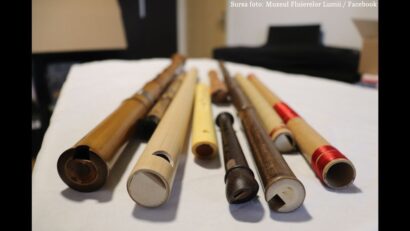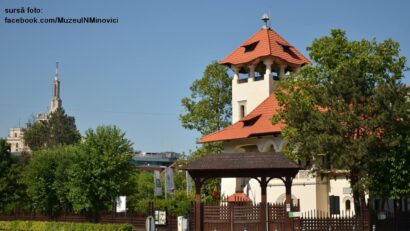Staters in Dobrogea
Staters are ancient Greek gold or silver coins that spread throughout Europe in the 4th century BC

Steliu Lambru, 22.06.2024, 12:33
Staters are ancient Greek gold or silver coins that spread throughout Europe in the 4th century BC. They were also discovered in the area of the Lower Danube or Dobrogea, on the territory of present-day Romania. In general, archaeologists and numismatists classify classical staters from the Hellenistic period of Southeast Europe into Alexander-type staters and Lysimachus-type staters. The names come from the most important conqueror of antiquity and one of the generals who crowned himself king of Thrace after his death.
On the western shore of the Black Sea, the Greek colonies were integrated into the Hellenistic world and economic exchanges were made in staters. The most powerful state in the area was the Kingdom of Pontus located east to the Black Sea. The most powerful sovereign of Pontus was Mithridates VI Eupathor, a tenacious opponent of the Roman Empire from the 2nd-1st centuries before Christ. The king of Pontus was one of those who issued staters that also reached the west Pontic shore.
Emanuel Petac is a numismatist and researcher at the Library of the Romanian Academy. He explains the spread of the staters on the western shore of the Black Sea and Dobrogea.
“In the middle of the 3rd century before Christ and in the second half of the same century, suddenly, the Black Sea fills up, it is flooded with a huge amount of gold. There are Alexander-type staters at Istros (Histria), at Callatis, at Odessos (today’s Varna), at Mesembria (today’s Nessebar), there are Lysimachus-type staters at Istros, at Tomis, at Byzantion (today’s Istanbul), at Odessos, Mesembria, but also at Tyras (today’s White Citadel). And all this in a certain geopolitical context, namely of the war between Byzantium, on the one hand, and the alliance between Istros, Callatis and possibly other cities on today’s Bulgarian coast today, on the other.”
The circulation of coins in the Black Sea basin is drastically reduced after the death of Lysimachus in 281. Emanuel Petac says there was a crisis of gold and silver in the second half of the 3rd century BC.
“Suddenly, around the year 200 and especially after, everything would return to the previous situation, in the sense that the precious metal disappears. We no longer have gold coin, we no longer have silver coin, it is clear that the mid-third century pieces had been heavily used until about 220-218, when the Greek colonies paid that huge, burdensome tribute to Cavaros to the kingdom of Tylis in the Balkans. So they still had something to pay the burdensome tribute. The revolt follows, the kingdom of Tylis falls and disappears, and after the year 200 there’s nothing left. What has happened? Basically what we see, say, around 200 are extremely rare issues of staters of the Lysimachus type, minted at Tomis, Istros or Tyras. I say they are so rare for good reason, and it is no coincidence that they are indeed rare to the level of uniqueness.”
The Lysimachus type staters minted at the court of Mithridates and discovered at Istros weigh an average of 8.18 grams and date from the time of the first war between the Kingdom of Pontus andRome in 88-86 BC. But archaeological excavations reveal not only the staters themselves, but also inscriptions that tell us about inter-human relationships in which the staters are involved, as Emanuel Petac summarizes the text of an inscription from Histria.
“The Histrian citadel had contracted a financial loan from a creditor in Byzantium of 100 staters which the Histrian citadel could no longer pay. It probably couldn’t pay them for a long enough time. The Byzantine creditor dies and the debt is inherited by his son. On the eve of the Mithridate wars, raising the question of the alliance between the West-Pontic cities and the Kingdom of Pontus, the Histrian city sends Mithridates a message that inevitably passes through Byzantium. The Histrian delegation was led by a certain Meniskos. Evidently this Meniskos must have been an extremely important person in the city, since he is entrusted with the message to Mithritates VI for such an important thing, the alliance with the king of Pontus.
The messager departs and reaches Byzantium, the claim being valid and enforceable, Byzantium arrests the Histrian messengers led by Meniskos and sends them to prison for a long period. Diogenes, Mithridates’ strategist, intervenes, pays the Histrian city’s debt to Byzantium, and Byzantium releases the Histrian messengers. So an outside character was needed to make the Histrian city fit to pay a debt of 100 staters. This is how the Histrian city had reached the end of the second century and the beginning of the first century before Christ unable to pay 100 staters when 100 or so years before it was flooded with Seleucid gold, and then Ptolemaic, which allowed it to mint thousands of staters.”
The Greek states of the Black Sea are artifacts of a dynamic economic space of the last two centuries before Christ. And those on the west coast are examples of the life of local communities integrated into a larger historical trend. (MI)





























